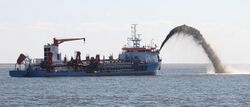Earth:Ocean dredging
Ocean dredging was an oceanography technique introduced in the nineteenth century and developed by naturalist Edward Forbes. This form of dredging removes substrate and fauna specifically from the marine environment. Ocean dredging techniques were used on the HMS Challenger expeditions as a way to sample marine sediment and organisms.[1][2]
History
Edward Forbes
Edward Forbes would lay out the dredged material on the deck to examine, preserve and study it. The practice was chronicled in a remembrance of Forbes by William Jerdan in his 1866 book Men I Have Known.[3]
HMS Challenger
Ocean dredging was a common sampling technique used on the Challenger expedition.[4] The expedition, led by oceanographer John Murray and chief scientist Charles Wyville Thomson, set sail in 1872 and returned to England in 1876.[4][2] The ship was equipped with 34 dredges and 20 dredge nets, completing 133 dredges at 111 stations during the 4 year long expedition.[5][4][1] Thomson and Murray detail the following instructions for surveying dredged organisms:

"Examine mud brought up by dredge from different depths for living diatoms; examine also for the same purpose the stomachs of Salpae and other marine animals."[5]
The expedition successfully dredged, collected, and preserved marine sediments, plants, algae, and invertebrates.[1] The Challenger expedition is attributed to discovering approximately 4,700 new marine species and expanding the current knowledge of ocean sediments and geology.[2][4][1]
Seafloor effects
Ocean dredging can negatively affect benthic ecosystems.[7] When dredging equipment is moved along the seafloor, habitat-forming epifauna is damaged or removed.[8] As emergent corals, sponges, and seagrasses are damaged there is less habitat complexity for juvenile fishes to find protection in.[8] Dredging also removes the sand waves in which juvenile Atlantic cod settle.[8]
The top 2–6 cm of marine substrate is disturbed during dredging, which can have negative impacts on deposit feeders, nutrient flux, and burrowing species.[9] Dredging is often banned or highly restricted within marine protected areas in order to protect recovering ecosystems.[8]
Equipment used
Dredging in the marine environment can be carried out with a variety of equipment, depending on the purpose of the dredge. If the purpose is to remove sand or redistribute sediment, then a dredge drag head attached to a trailing suction hopper dredger ship is used.[10] A fishing dredge (also known as a scallop dredge) is used for collecting edible species of oysters, mussels, scallops, clams, and crabs from the seafloor.[11]
See also
References
- ↑ 1.0 1.1 1.2 1.3 "HMS Challenger: a trailblazer for modern ocean science" (in en). https://www.rmg.co.uk/stories/topics/hms-challenger-expedition-oceanography-trailblazer.
- ↑ 2.0 2.1 2.2 F., Murray, John, 'Sir' Renard, A. (1891). Report on the scientific results of the exploring voyage of H.M.S. Challenger 1873-76, under the command of Captain George S. Nares, R.N., F.R.S., and the late Captain Tourle Thomson, R.N. Report on deep-sea deposits based on the specimens collected during the voyage of H.M.S. Challenger in the years 1872 to 1876. H.M.S.O. OCLC 900028367. http://worldcat.org/oclc/900028367.
- ↑ Jerdan, W. (1866). Men I Have Known. London: George Routledge and Sons. https://archive.org/details/menihaveknown00jerdgoog.
- ↑ 4.0 4.1 4.2 4.3 "The Challenger Expedition" (in en-US). https://divediscover.whoi.edu/history-of-oceanography/the-challenger-expedition/.
- ↑ 5.0 5.1 J, Wyville Thomson, C Murray (1885). The Voyage of H.M.S. Challenger 1873-1876. Narrative Vol. I. First Part. Chapter I. OCLC 795345570. http://worldcat.org/oclc/795345570.
- ↑ Thomson, C. Wyville (1878). The voyage of the "Challenger." The Atlantic; a preliminary account of the general results of the exploring voyage of H.M.S. "Challenger" during the year 1873 and the early part of the year 1876. New York: Harper & Brothers. doi:10.5962/bhl.title.79255. http://dx.doi.org/10.5962/bhl.title.79255.
- ↑ J. Sofonia, Jeremy; F. Unsworth, Richard K. (2010). "Development of water quality thresholds during dredging for the protection of benthic primary producer habitats" (in en). Journal of Environmental Monitoring 12 (1): 159–163. doi:10.1039/B904986J. PMID 20082009. https://pubs.rsc.org/en/content/articlelanding/2010/em/b904986j.
- ↑ 8.0 8.1 8.2 8.3 Lindholm, James B.; Auster, Peter J.; Ruth, Matthias; Kaufman, Les (2001). "Modeling the Effects of Fishing and Implications for the Design of Marine Protected Areas: Juvenile Fish Responses to Variations in Seafloor Habitat" (in en). Conservation Biology 15 (2): 424–437. doi:10.1046/j.1523-1739.2001.015002424.x. ISSN 0888-8892. http://doi.wiley.com/10.1046/j.1523-1739.2001.015002424.x.
- ↑ Thrush, Simon F.; Dayton, Paul K. (2002). "Disturbance to Marine Benthic Habitats by Trawling and Dredging: Implications for Marine Biodiversity". Annual Review of Ecology and Systematics 33 (1): 449–473. doi:10.1146/annurev.ecolsys.33.010802.150515. ISSN 0066-4162. http://dx.doi.org/10.1146/annurev.ecolsys.33.010802.150515.
- ↑ Agarwal, Mayur (2021). "Different Types of Dredgers Used in the Maritime Industry" (in en-US). https://www.marineinsight.com/types-of-ships/different-types-of-dredgers-used-in-the-maritime-industry/.
- ↑ "REVIEW OF EXISTING AND EMERGING ENVIRONMENTALLY FRIENDLY OFFSHORE DREDGING TECHNOLOGIES". 2004. https://www.boem.gov/sites/default/files/mm-research/2022-03/2004-076.pdf.
 |




